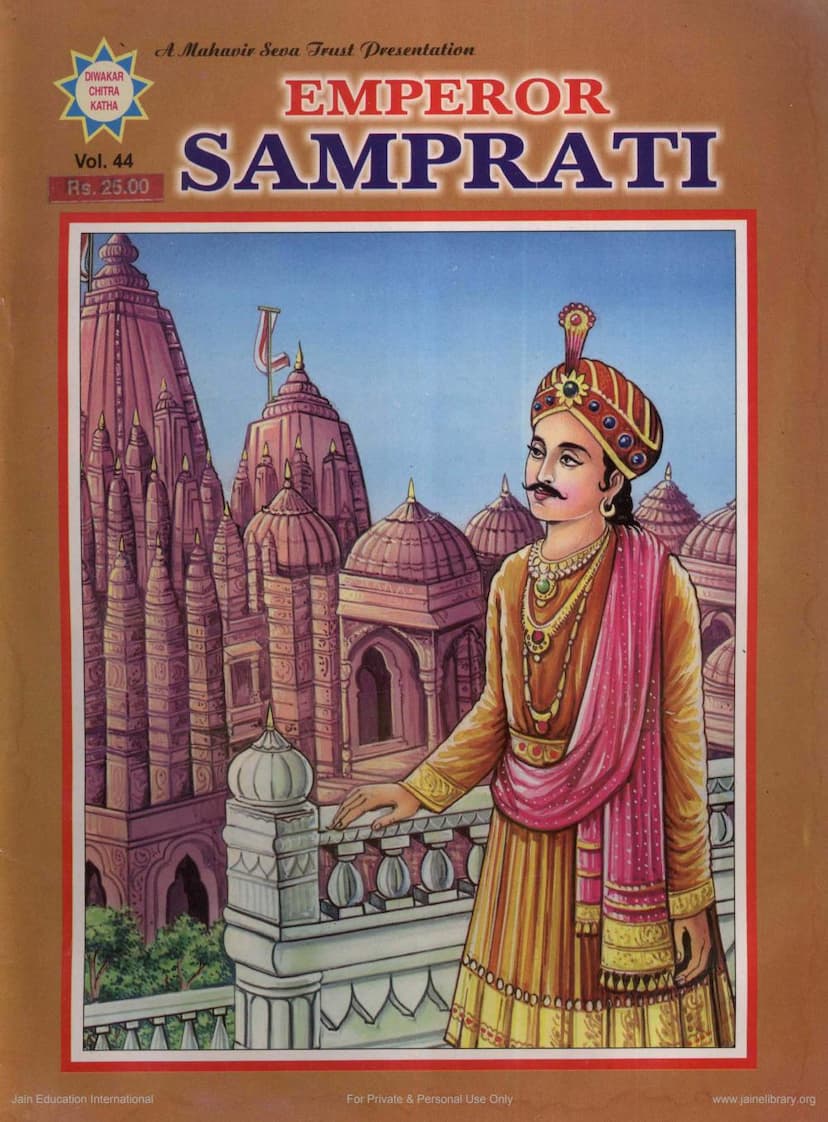Emperor Samprati Diwakar Chitrakatha 044
Added to library: September 1, 2025

Summary
Here is a comprehensive summary of "Emperor Samprati Diwakar Chitrakatha 044" in English:
This "Diwakar Chitrakatha" (Picture Story) book, Volume 44, tells the inspiring life story of Emperor Samprati. It highlights his immense contribution to the spread and establishment of Jainism, paralleling the significance of Emperor Ashoka in Buddhist history.
The narrative begins by establishing Emperor Samprati's historical importance, noting that while often overlooked by Indian historians, his impact on Jainism is profound. The story then delves into the early life of his father, Kunal, the son of Emperor Ashoka. Kunal, destined to be Ashoka's successor, was sent away to Avanti for safety due to the machinations of his stepmother, Tishyarakshita. Tishyarakshita deceitfully altered a letter from Ashoka, changing a command to "educate the prince" to "blind the prince." Consequently, Kunal, in his unwavering obedience to his father, had his eyes pierced with hot iron needles, blinding himself.
The story then follows Kunal's life in Avanti. Despite his blindness, he grew up with loving care and found solace in music and devotional songs. Upon reaching maturity, his governess, Sunanda, informed Emperor Ashoka, leading to Kunal being granted a small kingdom and married to Sharatshri. Kunal and Sharatshri lived a devout life, worshipping the Jina and engaging in religious activities. They were drawn to the teachings of Arya Suhasti, a Jain ascetic. Kunal, inspired by the ascetic's discourse, sought to embrace asceticism, but was advised to follow householder's vows due to his blindness. He and Sharatshri took these vows.
The narrative then shifts to a broader context, describing a severe drought and famine in Magadh and other regions, with people begging for food. The story then illustrates the principles of Jain conduct through the example of two ascetics seeking alms. A hungry beggar, astonished by the devotion and the rich food offered to the ascetics, observes their life. He encounters the ascetics, who direct him to their Guruji, Arya Suhasti. Arya Suhasti, seeing the beggar's plight, foresees that this soul will play a significant role in promoting Jainism. Recognizing the beggar's intense hunger, Arya Suhasti initiates him into asceticism, allowing him to eat freely. Tragically, the newly initiated ascetic overeats and dies of cholera, demonstrating the severe consequences of unchecked desires.
Back in Avanti, Kunal's wife, Sharatshri, gives birth to a son. Sunanda predicts a great future for the child, who is named Samprati. Kunal, inspired by Sunanda, decides to travel to Patliputra to seek a kingdom for his son from his father, Emperor Ashoka. Disguised as a poor singer named Suradas, Kunal reaches Patliputra and captivates the city with his music, eventually reaching Emperor Ashoka's court. Emperor Ashoka is profoundly moved by Suradas's music. Kunal then reveals his true identity, leading to an emotional reunion with his father. Ashoka, realizing Tishyarakshita's treachery, orders her imprisonment.
Ashoka learns about his grandson, Samprati, and rejoices. He declares Samprati as the crown prince and future ruler of Patliputra. Samprati receives princely education in politics and martial arts. He displays exceptional valor and intelligence, particularly when he tames a wild horse, impressing everyone. Ashoka, now elderly, announces his intention to retire and hand over the empire to Samprati, marking Samprati's coronation.
Following Ashoka's death, Emperor Samprati embarks on a mission to expand his empire, conquering Kashi, Kaushal, Malava, Gujarat, Saurashtra, and other states, thus spreading the Magadh empire across India. Upon his return to Avanti, his mother, Sharatshri, expresses concern about the violence involved in his conquests, questioning the happiness derived from an empire built on bloodshed. She advises him to seek guidance from Arya Suhasti.
Samprati, deeply affected by his mother's words, resolves to meet Arya Suhasti. He witnesses a grand religious procession and feels an inexplicable affection for a radiant saint in white attire, later identified as Arya Suhasti. He rushes to Arya Suhasti and learns that he was the beggar initiated in Kaushambi who died from overeating. Arya Suhasti explains the fruits of religious practice, emphasizing liberation as the ultimate goal. Samprati submits his empire to Arya Suhasti, but the Acharya declines, emphasizing detachment.
Samprati then seeks guidance on pleasing his mother and finding happiness. Arya Suhasti advises him to perform religious deeds and promises to guide him further. On the last day of a festival, Samprati instructs his courtiers to embrace Jainism and promote its activities. He is then guided by Arya Suhasti to construct and renovate Jain temples, becoming a staunch Shravak and strict follower of Jain vows. He resolves to eat only after hearing of temple construction or renovation each day.
Emperor Samprati then extends his efforts beyond India, sending scholars dressed as ascetics to foreign lands like Persia and Greece to construct temples and spread Jain teachings. He also emphasizes the importance of education, establishing schools and providing free education to all. The book highlights Samprati's immense spiritual merit gained through these welfare activities.
The story concludes with the passing of Arya Suhasti after a century of life and his handing over of leadership to his disciples. It is stated that Emperor Samprati installed approximately 12.5 million Jina images and facilitated the renovation of 6,600 ancient temples and the construction of 125,000 new ones, leaving an unparalleled legacy in the propagation of Jainism.
The latter part of the book includes a reflective essay titled "Happiness is Within Reach," which discusses the modern human condition driven by materialism, greed, and self-centeredness. It contrasts this with the principles of Jainism – Ahinsa, Syadvada, Karma, Aparigraha, and Karuna – as the path to true happiness, peace, and harmony. The essay encourages readers, especially the youth, to embrace these timeless teachings to lead a meaningful and fulfilling life.